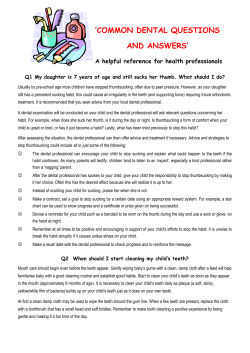
A Collaborative Effort between Indian Health Service (IHS) and
A Collaborative Effort between Indian Health Service (IHS) and the IHS Head Start Program Course Objectives 1. Describe Early Childhood Caries (ECC) 2. List two ways to prevent ECC. 3. Recognize the various stages of ECC. 4. Discuss the benefits of topical fluoride. 5. List the 5 steps to applying fluoride varnish. 6. Demonstrate the appropriate application of fluoride varnish. 7. List one key message for families to prevent ECC. Why are Baby Teeth Important? Eating and nutrition Holding space for the permanent teeth Talking Smiling What is Early Childhood Caries? ECC is the presence of any decayed, filled, or extracted (due to decay) teeth in the primary dentition (baby teeth). Involves infectious bacteria, often passed from mothers to babies. The teeth often decay very quickly. Effects of ECC Pain Infection Higher risk of new cavities Missed school days and difficulty concentrating in school What Causes ECC? Pathological Factors Bacterial biofilm Ingestion of simple carbohydrates Reduced salivary function TOOTH DECAY Protective Factors Fluoride Antibacterials Oral hygiene habits Flow and composition of saliva Structure of tooth minerals in each individual Dental Sealants NO TOOTH DECAY Demineralization and Remineralization ECC and AI/AN Children • 76% of AI/AN children ages 2-5 have experienced dental cavities. • 68% have untreated decay. • Over 50% have severe ECC. 1999 IHS Oral Health Survey Two is Too Late! Costs of ECC Traditional dental treatment is largely ineffective at reducing the bacteria that cause ECC. ECC can cost thousands of dollars to treat each child, even exceeding $8,000 when a child is hospitalized and treated under general anesthesia. Dental Programs Medical and Public Health Programs CHR s IHS DOH ECC Initiative Head Start WIC Tribal Organizations Fluoride Inhibits demineralization Enhances remineralization Inhibits plaque bacteria Ways to Obtain Fluoride: Systemic Water Prescription drops or tablets Ways to Obtain Fluoride: Topical Fluoride Toothpaste Fluoride Varnish Fluoride Mouthrinses Fluoride Toothpaste Recommend cleaning the teeth daily with a small smear of fluoride toothpaste as soon as the first tooth erupts. At three years of age, brush daily with a pea-size dab of fluoride toothpaste Topical Fluoride Recommendations for High-Risk Children. Development of Decision Support Matrix: Recommendations from MCHB Expert Panel, 2008 What is Fluoride Varnish? Highly concentrated topical fluoride treatment Can reverse white spot lesions. Safe for young children Easy to apply Advantages of Fluoride Varnish Safe Easy to Apply Accepted by patients No special requirements Research with AIAN children Medical staff applied during well-child visits. Children who received four or more application of varnish between the ages of 9-24 months of age had 35% reduced decayed surfaces over children who received none. Holve S, IHS Primary Care Provider, Oct 2006. Due to the high prevalence of dental caries, most AI/AN children can be considered high-risk for dental caries . unless a dental professional has classified them differently Who does What in AI/AN Communities? Age Staff Protocol 9-24 months Medical Staff 4 treatments 2-3 years CHRs, WIC, PHNs 3-4 treatments 3-5 years Head Start staff 3-4 treatments per year Work together to prevent ECC! Fluoride varnish for every infant and child Dental screenings Parent education Caries Stabilization 5 Steps to Applying Fluoride Varnish Step 1: Getting Ready Supplies Fluoride Varnish Gauze squares Non-latex gloves Child-size toothbrush (optional) Principles of Infection Control 1. Take action to stay healthy: wash hands or use an alcohol-based hand rub before and after applying varnish on each child. 2. Avoid contact with blood and body fluids: wear gloves. 3. Make items safe for use: use all disposable items. 4. Limit contamination: set up on a paper towel and dispose of all items after each application. Applying Infection Control Principles Set Up Application Clean Up Step 2: Oral Health Assessment • Use the knee to knee position if you are working with babies and very young children. • Children 3 and older can stand in front of you. If you use a toothbrush… Show the caregivers how to brush Use the toothbrush as a mouth prop Oral Health Assessment First Sign of ECC: White Spot Lesions Can be remineralized with Changes in diet Fluoride varnish Daily brushing with fluoride toothpaste. Early and Moderate ECC Caries Stabilization: ITR Ask your dental clinic if they provide Caries Stabilization and ITR for young children. Severe ECC Step 3: Dry the teeth Use the gauze squares Step 4: Apply Fluoride Varnish http://www.youtube.com/watch?v=cV5OmL7C8K4 Step 5: Take Home Messages Don’t brush until the next day for optimal benefit of the fluoride varnish. Brush daily with a fluoride toothpaste. 5 Steps Review Note: During all steps, be sure to follow the principles of infection control. All of the supplies are disposable and intended for single use only! What can YOU do to prevent ECC? • Provide oral health screenings and fluoride varnish for the children you work with. • Provide oral health messages to families in your community. Summary Instructions for Course Completion After completing the course and receiving a score of at least 80% on the posttest, you will receive a certificate. After demonstrating application of fluoride varnish on a child in the appropriate age group, have a medical or dental health professional sign your certificate. Standing orders must be provided by a dentist or physician. Make sure he/she is licensed in the state you work in if you will be providing fluoride varnish treatments for nonnative children. Special Thanks We want to thank California First Smiles for use of some of their photos and Dr. Joanna Douglass for use of her video.
© Copyright 2025














![] How to…Implement a FMBCS BI Solution Johannes Lombard LSI Consulting](http://cdn1.abcdocz.com/store/data/000181420_1-6cb5bac3f26630bd4c7bfc8846e3e9e6-250x500.png)




